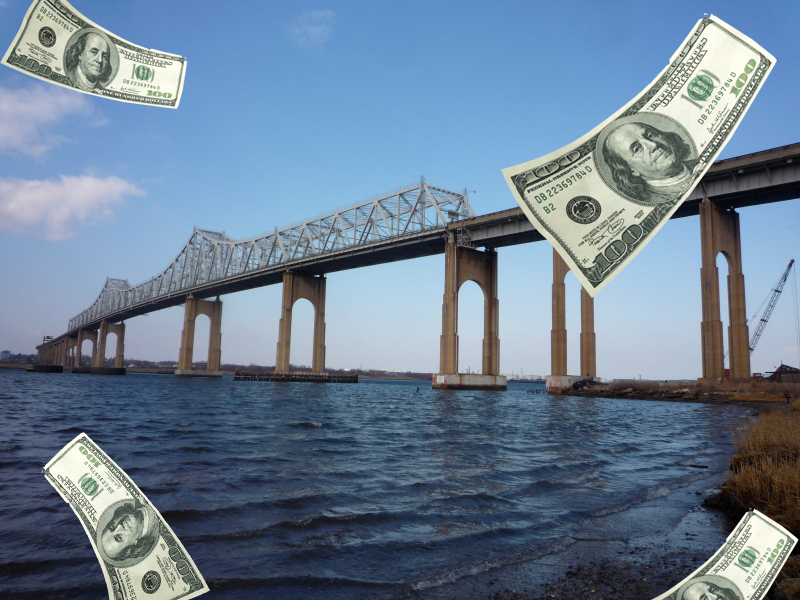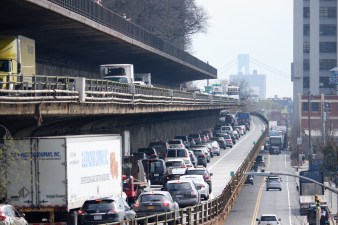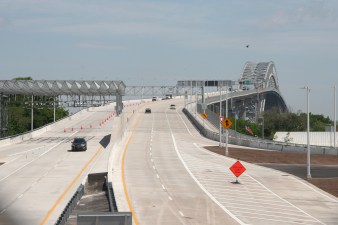Port Authority Study Could Lead to More Traffic Jams on Outerbridge Crossing
The agency says it will examine 'widening' the bridge — a sure-fire way to draw more cars and congestion.

When it comes to cars, if you build it, they will come — so why did the Port Authority announce last week that it is studying “widening” the Outerbridge Crossing?
The agency said that despite the conventional definition of the word “widening,” it isn’t sure whether the study will recommend adding more lanes on the span between Staten Island and Perth Amboy, N.J. But adding road capacity is what road widening typically entails — which is not a surprising goal given that the Outerbridge is notoriously narrow with two, 10-foot-wide lanes in each direction in an era when 12-foot-wide lanes are the national standard.
Narrower lanes do tend to slow down drivers, but widening the roadway would be counterproductive to Port Authority Chairman Kevin O’Toole’s goal to “speed travel across the bridge,” experts said, citing decades of research demonstrating that building new capacity simply brings more cars to the road, perversely adding to traffic rather than relieving it.
This well-known phenomenon — called “induced demand” — has played out time and time again across the country and brought more pollution and greenhouse gas emissions even as Americans should be cleaning up the transportation system.
“Adding new lanes would be the wrong approach to addressing this commuter headache,” said Matthew Casale, environment campaigns director at USPIRG. “We should be looking to make it easier for people to get where they need to go without having to sit in traffic alone in their car on a bridge.”
Officially, Port Authority spokesman Scott Ladd said only that answers “about lane size and number, and cost … are not yet available” because the agency is so early in the process. It’s a process that has been ongoing, apparently.
The new study is only the latest chapter in the agency’s bid to renew the 94-year-old span, which carries about 30 million car trips per year. Last December, Gov. Hochul signed legislation directing the authority to study the possibility of widening the Outerbridge in order to increase traffic flow.
“As it is currently built, the Outerbridge Crossing’s narrow lanes and inadequate traffic flow are a frequent commuter headache. We hope to expedite the process of dramatically improving quality of life and enhancing safety for commuters from New York and New Jersey alike,” she said.
In 2020, the agency completed what it calls a “comprehensive study of rehabilitation options for the bridge,” but one that clearly wasn’t comprehensive enough, given the need for a new study less than two years later.
“Our 2020 study was intended to be comprehensive, and this added chapter will fulfill that intent and ensure solid analysis of all rehabilitation options,” said Port Authority Executive Director Rick Cotton. (The agency declined to make the 2020 study available to Streetsblog, which was told to file a Freedom of Information Law request, even though a section for studies and reports appears on its website.)
Even before the earlier study, Staten Island Republicans, including Council Member Joe Borelli and then-Assembly Member Nicole Malliotakis, began agitating for widening the Outerbridge in 2016, arguing that congestion necessitated expanding the bridge’s capacity.
A road widening did not work out so well for the Kosciuszko Bridge on the Brooklyn-Queens Expressway, which carries some 160,000 vehicles daily and is notorious for its congestion. The 1939 span was torn down and replaced with a wider span that was completed in 2019. The rebuilt bridge features the same old rush-hour traffic jam, however, despite the extravagant promises of then-Gov. Cuomo that extra lanes would speed travel times.
The Outerbridge Crossing is named after former Port Authority Chairman Eugenius H. Outerbridge and not, as many New Yorkers believe, because of its distant locale at the very western edge of the city.


